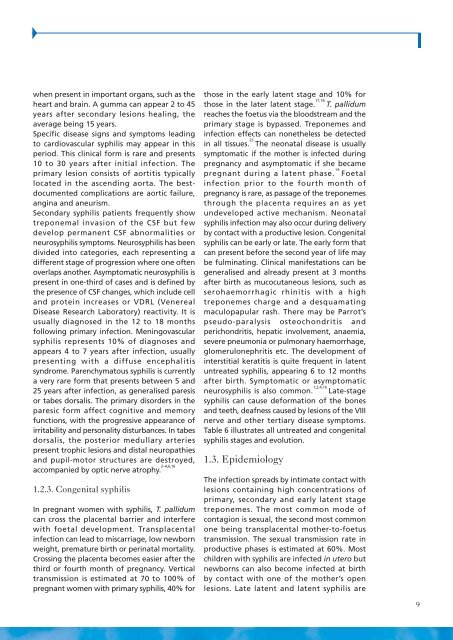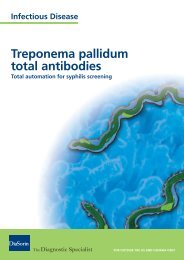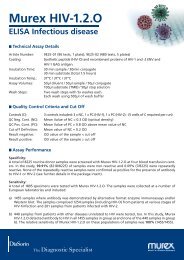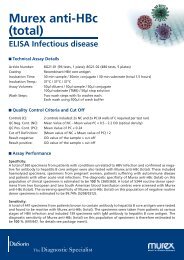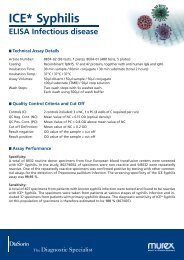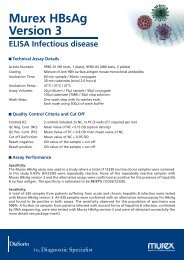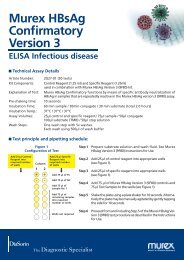Syphilis Booklet - DiaSorin
Syphilis Booklet - DiaSorin
Syphilis Booklet - DiaSorin
You also want an ePaper? Increase the reach of your titles
YUMPU automatically turns print PDFs into web optimized ePapers that Google loves.
when present in important organs, such as the<br />
heart and brain. A gumma can appear 2 to 45<br />
years after secondary lesions healing, the<br />
average being 15 years.<br />
Specific disease signs and symptoms leading<br />
to cardiovascular syphilis may appear in this<br />
period. This clinical form is rare and presents<br />
10 to 30 years after initial infection. The<br />
primary lesion consists of aortitis typically<br />
located in the ascending aorta. The bestdocumented<br />
complications are aortic failure,<br />
angina and aneurism.<br />
Secondary syphilis patients frequently show<br />
treponemal invasion of the CSF but few<br />
develop permanent CSF abnormalities or<br />
neurosyphilis symptoms. Neurosyphilis has been<br />
divided into categories, each representing a<br />
different stage of progression where one often<br />
overlaps another. Asymptomatic neurosyphilis is<br />
present in one-third of cases and is defined by<br />
the presence of CSF changes, which include cell<br />
and protein increases or VDRL (Venereal<br />
Disease Research Laboratory) reactivity. It is<br />
usually diagnosed in the 12 to 18 months<br />
following primary infection. Meningovascular<br />
syphilis represents 10% of diagnoses and<br />
appears 4 to 7 years after infection, usually<br />
presenting with a diffuse encephalitis<br />
syndrome. Parenchymatous syphilis is currently<br />
a very rare form that presents between 5 and<br />
25 years after infection, as generalised paresis<br />
or tabes dorsalis. The primary disorders in the<br />
paresic form affect cognitive and memory<br />
functions, with the progressive appearance of<br />
irritability and personality disturbances. In tabes<br />
dorsalis, the posterior medullary arteries<br />
present trophic lesions and distal neuropathies<br />
and pupil-motor structures are destroyed,<br />
accompanied by optic nerve atrophy. 2–4,6,16<br />
1.2.3. Congenital syphilis<br />
In pregnant women with syphilis, T. pallidum<br />
can cross the placental barrier and interfere<br />
with foetal development. Transplacental<br />
infection can lead to miscarriage, low newborn<br />
weight, premature birth or perinatal mortality.<br />
Crossing the placenta becomes easier after the<br />
third or fourth month of pregnancy. Vertical<br />
transmission is estimated at 70 to 100% of<br />
pregnant women with primary syphilis, 40% for<br />
those in the early latent stage and 10% for<br />
those in the later latent stage. 17,18 T. pallidum<br />
reaches the foetus via the bloodstream and the<br />
primary stage is bypassed. Treponemes and<br />
infection effects can nonetheless be detected<br />
in all tissues. 25 The neonatal disease is usually<br />
symptomatic if the mother is infected during<br />
pregnancy and asymptomatic if she became<br />
pregnant during a latent phase. 19 Foetal<br />
infection prior to the fourth month of<br />
pregnancy is rare, as passage of the treponemes<br />
through the placenta requires an as yet<br />
undeveloped active mechanism. Neonatal<br />
syphilis infection may also occur during delivery<br />
by contact with a productive lesion. Congenital<br />
syphilis can be early or late. The early form that<br />
can present before the second year of life may<br />
be fulminating. Clinical manifestations can be<br />
generalised and already present at 3 months<br />
after birth as mucocutaneous lesions, such as<br />
serohaemorrhagic rhinitis with a high<br />
treponemes charge and a desquamating<br />
maculopapular rash. There may be Parrot’s<br />
pseudo-paralysis osteochondritis and<br />
perichondritis, hepatic involvement, anaemia,<br />
severe pneumonia or pulmonary haemorrhage,<br />
glomerulonephritis etc. The development of<br />
interstitial keratitis is quite frequent in latent<br />
untreated syphilis, appearing 6 to 12 months<br />
after birth. Symptomatic or asymptomatic<br />
neurosyphilis is also common. 1,2,4,16 Late-stage<br />
syphilis can cause deformation of the bones<br />
and teeth, deafness caused by lesions of the VIII<br />
nerve and other tertiary disease symptoms.<br />
Table 6 illustrates all untreated and congenital<br />
syphilis stages and evolution.<br />
1.3. Epidemiology<br />
The infection spreads by intimate contact with<br />
lesions containing high concentrations of<br />
primary, secondary and early latent stage<br />
treponemes. The most common mode of<br />
contagion is sexual, the second most common<br />
one being transplacental mother-to-foetus<br />
transmission. The sexual transmission rate in<br />
productive phases is estimated at 60%. Most<br />
children with syphilis are infected in utero but<br />
newborns can also become infected at birth<br />
by contact with one of the mother’s open<br />
lesions. Late latent and latent syphilis are<br />
9


